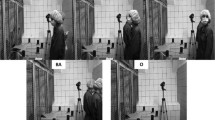Abstract
Studies of great apes have revealed that they use manual gestures and other signals to communicate about distal objects. There is also evidence that chimpanzees modify the types of communicative signals they use depending on the attentional state of a human communicative partner. The majority of previous studies have involved chimpanzees requesting food items from a human experimenter. Here, these same communicative behaviors are reported in chimpanzees requesting a tool from a human observer. In this study, captive chimpanzees were found to gesture, vocalize, and display more often when the experimenter had a tool than when she did not. It was also found that chimpanzees responded differentially based on the attentional state of a human experimenter, and when given the wrong tool persisted in their communicative efforts. Implications for the referential and intentional nature of chimpanzee communicative signaling are discussed.





Similar content being viewed by others
References
Bard K (1992) Intentional behavior and intentional communication in young free-ranging orangutans. Child Dev 63:1186–1197
Call J, Tomasello M (1994) Production and comprehension of referential pointing by orangutans (Pongo pygmaeus). J Comp Psychol 108:307–317
De Waal F (1988) The communicative repertoire of captive bonobos, Pan paniscus, compared to that of chimpanzees. Behaviour 106:183–251
Goodall J (1986) The chimpanzees of Gombe: patterns in adaptation. Harvard University Press, Cambridge, Mass.
Harding CG, Golinkoff RM (1979) The origins of intentional vocalizations in prelinguistic infants. Child Dev 50:33–40
Hostetter AB, Cantero M, Hopkins WD (2001) Differential use of vocal and gestural communication by chimpanzees (Pan troglodytes) in response to the attentional status of a human (Homo sapiens). J Comp Psychol 115:337–343
Krause MA, Fouts RS (1997) Chimpanzee (Pan troglodytes) pointing: hand shapes, accuracy, and the role of eye gaze. J Comp Psychol 111:330–336
Leavens DA, Hopkins WD (1998) Intentional communication by chimpanzees: a cross-sectional study of the use of referential gestures. Dev Psychol 34:813–822
Leavens DA, Hopkins WD (1999) The whole-hand point: the structure and function of pointing from a comparative perspective. J Comp Psychol 113:417–425
Leavens DA, Hopkins WD, Bard KA (1996) Indexical and referential pointing in chimpanzees (Pan troglodytes). J Comp Psychol 110:346–353
Leavens DA, Hopkins WD, Thomas RK (2004) Referential communication by Chimpanzees (Pan troglodytes). J Comp Psychol 118:48–57
Leavens DA, Russell JL, Hopkins WD (2005) Intentionality as measured in the persistence and elaboration of communication by chimpanzees (Pan troglodytes). Child Dev 76:291–306
Liebal K, Pika S, Call J, Tomasello M (2004) To move or not to move: how apes adjust to the attentional state of others. Interact Stud 5:199–219
Pika S, Liebal K, Tomasello M (2003) Gestural communication in young gorillas (Gorilla gorilla): gestural repertoire, learning, and use. Am J Primatol 60:95–111
Povinelli DJ, Eddy TJ (1996) Factors influencing young chimpanzees’ (Pan troglodytes) recognition of attention. J Comp Psychol 110:336–345
Schaller GB (1963) The mountain gorillas. Ecology and behavior. University of Chicago Press, Chicago
Tanner JE, Byrne R (1996) Representation of action through iconic gesture in captive lowland gorilla. Curr Anthropol 37:162–173
Tanner JE, Byrne R (1999) The development of spontaneous gestural communication in a group of zoo-living lowland gorillas. In: Parker T, Milks S, Mitchell R (eds) The mentalities of gorillas and orangutans, comparative perspectives. Cambridge University Press, Cambridge, Mass., pp 211–239
Tomasello M, George BL, Kruger AC, Farrar MJ, Evans A (1985) The development of gestural communication in young chimpanzees. J Hum Evol 14:175–186
Tomasello M, Call J, Nagell K, Olguin R, Carpenter M (1994) The learning and use of gestural signals by young chimpanzees: a trans-generational study. Primates 37:137–154
Tomasello M, Camaioni L (1997) A comparison of the gestural communication of apes and human infants. Human Dev 40:7–24
Acknowledgments
This work was supported in part by NIH grants RR-00165, U42-RR-15090, NS-42867, NS-36605 and HD-38051. We thank the care staff from each facility for assistance in data collection. The YRPRC and UTMDACC facilities are accredited by the Association for Assessment and Accreditation of Laboratory Animal Care International. American Psychological Association guidelines for the care and use of animals were adhered to during all aspects of this study
Author information
Authors and Affiliations
Corresponding author
Rights and permissions
About this article
Cite this article
Russell, J.L., Braccini, S., Buehler, N. et al. Chimpanzee (Pan troglodytes) intentional communication is not contingent upon food. Anim Cogn 8, 263–272 (2005). https://doi.org/10.1007/s10071-005-0253-3
Received:
Revised:
Accepted:
Published:
Issue Date:
DOI: https://doi.org/10.1007/s10071-005-0253-3




